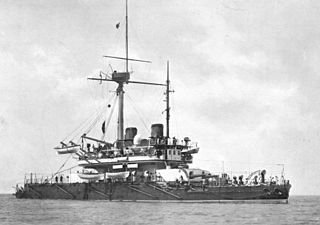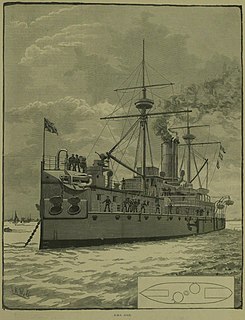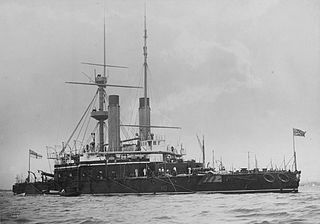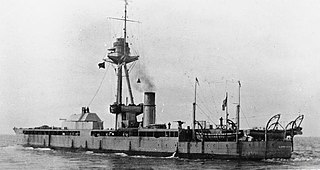
The Royal Sovereign class was a group of eight pre-dreadnought battleships built for the Royal Navy in the 1890s. The ships spent their careers in the Mediterranean, Home and Channel Fleets, sometimes as flagships, although several were mobilised for service with the Flying Squadron in 1896 when tensions with the German Empire were high following the Jameson Raid in South Africa. Three ships were assigned to the International Squadron formed when Greek Christians rebelled against the Ottoman Empire′s rule in Crete in 1897–1898.

HMS Queen Elizabeth was the lead ship of her class of five dreadnought battleships built for the Royal Navy in the early 1910s, and was often used as a flagship. She served in the First World War as part of the Grand Fleet, and participated in the inconclusive action of 19 August 1916. Her service during the war generally consisted of routine patrols and training in the North Sea. She and the other super-dreadnought battleships were the first of their type to be powered by oil instead of coal. Queen Elizabeth later served in several theatres during the Second World War, and was ultimately scrapped in 1948.

HMS Prince of Wales was a London-class pre-dreadnought battleship built for the Royal Navy in the first decade of the 20th century. She was one of two ships of the London- or Queen sub-class. Shortly after completion the ship was assigned to the Mediterranean Fleet and then to the Atlantic in 1909 and Home Fleets three year later. Prince of Wales often served as a flagship during her career.

HMS Dreadnought was an ironclad turret ship built for the Royal Navy during the 1870s. Construction was halted less than a year after it began and she was redesigned to improve her stability and buoyancy. Upon completion in 1879, the ship was placed in reserve until she was commissioned in 1884 for service with the Mediterranean Fleet. Upon her return 10 years later, she became a coast guard ship in Ireland for two years. The ship then became a depot ship in 1897 before she was reclassified as a second-class battleship in 1900. Dreadnought participated in the annual fleet manoeuvres for the next two years before she became a training ship in 1902. The ship was taken out of service three years later and sold for scrap in 1908.

The Beagle class was a class of sixteen destroyers of the Royal Navy, all ordered under the 1908-1909 programme and launched in 1909 and 1910. The Beagles served during World War I, particularly during the Dardanelles Campaign of 1915.

HMS Thunderer was one of two Devastation-class ironclad turret ships built for the Royal Navy in the 1870s. She suffered two serious accidents before the decade was out and gained a reputation as an unlucky ship for several years afterward. The ship was assigned to the Mediterranean Fleet in 1878 and was reduced to reserve in 1881 before being recommissioned in 1885. Thunderer returned home in 1887 and was again placed in reserve. She rejoined the Mediterranean Fleet in 1891, but was forced to return to the UK by boiler problems the following year. The ship became a coast guard ship in Wales in 1895 and was again placed in reserve in 1900. Thunderer was taken out of service in 1907 and sold for scrap in 1909.

Satsuma (薩摩) was a semi-dreadnought battleship built for the Imperial Japanese Navy (IJN) in the first decade of the 20th century. Lead ship of her class, she was the first battleship built in Japan. She was named for Satsuma Province, now a part of Kagoshima prefecture. The ship saw no combat during World War I, although she led a squadron that occupied several German colonies in the Pacific Ocean in 1914. Satsuma was disarmed and sunk as a target in 1922–1924 in accordance with the terms of the Washington Naval Treaty of 1922.

Aki (安芸) was one of two Satsuma-class semi-dreadnought battleship built for the Imperial Japanese Navy (IJN) during the first decade of the 20th century. She was the second battleship built domestically in Japan and the first to use steam turbines for propulsion. The ship was named for Aki Province, now a part of Hiroshima Prefecture. The ship saw no combat during World War I. Aki was disarmed in 1922 and sunk as a target in 1924 in accordance with the terms of the Washington Naval Treaty of 1922.

The Lord Clive-class monitor, sometimes referred to as the General Wolfe class, were ships designed for shore bombardment and were constructed for the Royal Navy during the First World War.

HMS Ajax was the name ship of her class of ironclad battleships built for the Royal Navy during the 1870s. Completed in 1883, she was immediately placed in reserve until 1885 when the ship was commissioned for the first time. Later that year, Ajax was assigned as a coast guard ship in Scotland and remained there for the next six years. She was reduced to reserve again in 1891 and was taken out of service a decade later. The ship was sold for scrap in 1904 and subsequently broken up.

HMS Nile was one of two Trafalgar-class ironclad battleships built for the Royal Navy during the 1880s. Late deliveries of her main guns delayed her commissioning until 1891 and she spent most of the decade with the Mediterranean Fleet. Nile returned home in 1898 and became the coast guard ship at Devonport for five years before she was placed in reserve in 1903. The ship was sold for scrap in 1912 and broken up at Swansea, Wales.

HMS Cumberland was one of 10 Monmouth-class armoured cruisers built for the Royal Navy in the first decade of the 20th century. She was assigned to the 2nd Cruiser Squadron of the Channel Fleet upon completion in 1903. After a refit in 1907–08 she became a training ship in the Home Fleet. She was sent to West Africa after the beginning of World War I in August 1914 and captured 10 German merchant ships in September. Cumberland spent the rest of the war on convoy escort duties and patrolling for German commerce raiders. She was sold for scrap in 1921 and broken up two years later.
HMS Prince Eugene was one of eight Lord Clive-class monitors built for the Royal Navy in 1915 to conduct shore bombardments during the First World War. The ship was assigned to the Dover Patrol for the duration of the war and provided cover for the Inshore Squadron during the First Ostend Raid. She was sold for scrap in 1921.

HMS General Craufurd was the one of eight Lord Clive-class monitors built for the Royal Navy during World War I. Their primary armament was taken from obsolete pre-dreadnought battleships. The ship spent the war in the English Channel bombarding German positions along the Belgian coast as part of the Dover Patrol. She participated in the failed First and Second Ostend Raids in 1918, bombarding the defending coastal artillery as the British attempted to block the Bruges–Ostend Canal. Later that year General Craufurd supported the coastal battles during the Hundred Days Offensive until the Germans evacuated coastal Belgium in mid-October. The ship was decommissioned almost immediately after the war ended the following month, but she was reactivated in 1920 to serve as a gunnery training ship for a year. General Craufurd was sold for scrap in 1921.

HMS Lord Clive was the lead ship of her class of eight monitors built for the Royal Navy during World War I. Their primary armament was taken from obsolete pre-dreadnought battleships. The ship spent the war in the English Channel bombarding German positions along the Belgian coast as part of the Dover Patrol, often serving as a flagship. She participated in the failed First Ostend Raid in 1918, bombarding the defending coastal artillery as the British attempted to block the Bruges–Ostend Canal. Lord Clive was one of two ships in the class fitted with a single 18-inch (457 mm) gun in 1918, but she only fired four rounds from it in combat before the end of the war in November. The ship conducted gunnery trials after the war and was sold for scrap in 1927.

The Satsuma class was a pair of semi-dreadnought battleships built for the Imperial Japanese Navy (IJN) in the first decade of the 20th century. They were the first battleships to be built in Japan and marked a transitional stage between the pre-dreadnought and true dreadnought designs. They saw no combat during World War I, although Satsuma led a squadron that occupied several German colonies in the Pacific Ocean in 1914. Both ships were disarmed and expended as targets in 1922–1924 in accordance with the terms of the Washington Naval Treaty of 1922.

The Gorgon-class monitors were a class of monitors in service with the Royal Navy during World War I. Gorgon and her sister ship Glatton were originally built as coastal defence ships for the Royal Norwegian Navy, as HNoMS Nidaros and HNoMS Bjørgvin respectively but requisitioned for British use. Gorgon commissioned first, in June 1918 and bombarded German positions and other targets in Occupied Flanders. She fired the last shots of the war by the Royal Navy into Belgium on 15 October 1918. She was offered for sale after the war, but was used as a target ship when there were no takers. She was sold for scrap in 1928. Glatton was destroyed by a magazine explosion only days after she was completed in September 1918 while in Dover Harbour. She remained a hazard to shipping until the wreck was partially salvaged and the remains moved out of the way during 1925–26.

HMS Gorgon was the first ship commissioned of the four Cyclops-class breastwork monitors built for the Royal Navy during the 1870s.

The Kalamazoo-class monitors were a class of ocean-going ironclad monitors begun during the American Civil War. Unfinished by the end of the war, their construction was suspended in November 1865 and the unseasoned wood of their hulls rotted while they were still on the building stocks. If the four ships had been finished they would have been the most seaworthy monitors in the US Navy. One was scrapped in 1874 while the other three were disposed of a decade later.
The Greek ironclad Vasilefs Georgios was an armored corvette built in Great Britain for the Royal Hellenic Navy during the 1860s. She became a cadet training ship before she was stricken from the Navy List in 1912. The ship was scrapped in 1915.

















